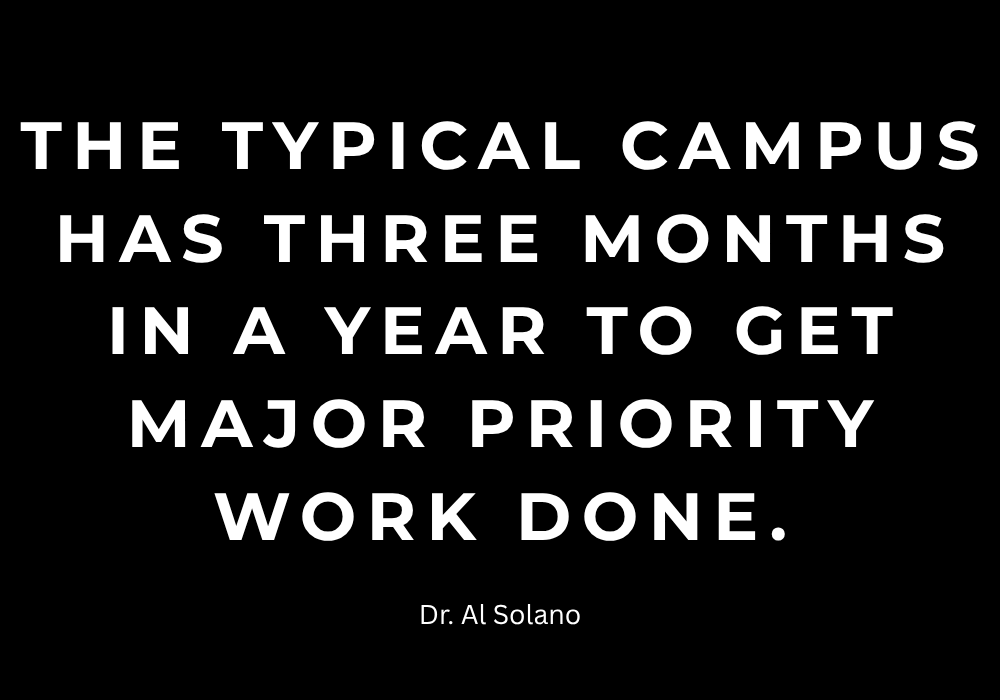The 3-Month Rule, Revisited | 003 | Time & Execution
What we normalize is what we get—delays included.
It’s been many years since I wrote about the 3-month rule, and I stand by it. In fact, I might revise it. With the rise of unproductive rivalries and workplace bullying, we might be down to two months now.
That’s right. On most campuses, when you subtract the “startup chaos,” “holiday wind-down,” “we’re off-contract,” “spring fatigue,” and “everyone’s at a conference,” you’re left with about two windows a year when real planning and implementation for major priority work can happen. October and March. Maybe.
I know it sounds cynical. It’s not. It’s a reality check. And it’s one I’ve watched stall reform efforts for over decades.
How the 3-Month Rule Started
When I used to secure and implement multi million-dollar five-year grants such as Strengthening Institutions and Hispanic-Serving Institutions initiatives, I noticed how the reality of the calendar got in the way of progress (among other things). But this time constraint wasn’t specific to grants. It impacts all initiatives. Take Guided Pathways. For example, California gave colleges five years of significant funding—60 months. I remember doing the math and thinking:
“Given the way higher ed works, they really only have 15 months to implement a culture-changing framework.”
Turns out that was generous.
Fast-forward through a pandemic, performative fatigue, Zoom burnout, the inherent dysfunction of the committee structure, interest group politics, unproductive rivalries, and workplace bullying, and I’d say most colleges now have maybe 2 relatively high-functioning months per year to do actual transformation work.
That’s not a knock on anyone per se. It’s a call to face how the culture of delay and deferral kills momentum.
Let’s Map It Out (Again)
Let’s take a typical college calendar and see where time goes:
June, July, August: “Campus goes dark. Nothing happens.”
September: “Too hectic—start of the semester.”
October: “Good month for priorities... unless everyone’s at conferences.”
November/December: “Holidays, breaks, finals—barely two meetings happen.”
January: “No one really comes back until late in the month.”
February: “Start-of-semester chaos, again.”
March: “OK, let’s try to focus again.”
April: “Spring break. Hit or miss.”
May: “Too busy with end-of-year stuff.”
So, what are we left with?
October and March. That’s your window. And even that’s iffy now.
Stop Wasting the Time You Do Have
This isn’t just about the calendar. It’s about how poorly we use the little time we get. If you’re leading transformational work, here are some reminders (all still true today):
Don’t aim for perfect attendance. If 60–70% of your team shows up, that’s enough. Stop repeating everything for the late crowd. That’s what meeting notes are for.
Don’t chase unanimity. You’re not voting on pizza toppings. General consensus is enough.
Meet more than once a month. Ideally 3x/month. If it matters, treat it like it matters.
Prep your meetings. A meeting without a purpose is just a vibe check that wastes people’s time.
Honor people’s time. Start on time. End on time. Don’t punish the people who show up on time.
Document and share. Don’t let your workgroups become silos.
Stop Using the Calendar as a Shield
“I mean, nothing happens in summer...”
“We’ll pick this up in fall...”
“We’ll revisit in the spring...”
The calendar has become one of the most powerful stalling tactics in higher education. And we all know it. The most successful campuses I work with don’t “pause” over breaks. They don’t pretend they’ll get back to it “when things calm down.”
They:
Hold virtual mini-retreats and meetings
Offer modest stipends for faculty to stay engaged over breaks
Learn from other colleges and the literature
Keep at least a trickle of momentum going
You don’t have to make decisions year-round. But you do have to keep the engine warm.
We are still losing time to indecision, inaction, and “waiting for the right moment.”
That moment’s not coming.
If your student success rates are dismal—in the single digits at some institutions—you don’t get to wait. You have to problem-solve with action.
The 3-month rule still stands.
But in most places, it’s a 2-month window now—and even that’s being chipped away.
Don’t be the typical campus.
Onward…
Dr. Al Solano
Founder, Continuous Learning Institute | About
Host, Student Success Podcast
A meaningful test of success is how helpful we are in contributing to our fellow human being’s happiness.


